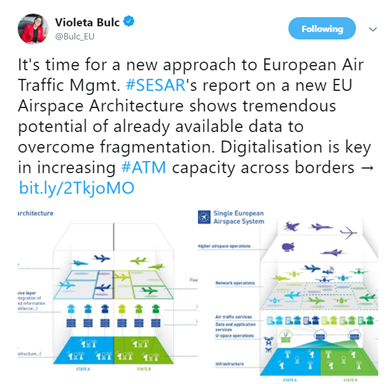
The Airspace Architecture Study was the topic of discussion at a recent event hosted by the Sky and Space Intergroup at the European Parliament on 5 March. The study, which was recently delivered by the SESAR Joint Undertaking to the European Commission, proposes a rethink of Europe's airspace architecture in order to increase the capacity and resilience of Europe’s busy skies.
Opening the event, Monika Hohlmeier, MEP and chair of the Sky and Space Intergroup, welcomed the report and its timeliness given the growing air traffic and the delays experienced in 2018. Marian-Jean Marinescu, MEP, and vice chair of the Sky and Space Intergroup, said that the study offers more than expected in terms of digital solutions and an implementation plan for better managing Europe’s skies. Filip Cornelis, Director of Aviation, DG MOVE, agreed that the study offered a tangible way forward to helping to cope with growth and avoid delays passengers have been witnessing.
 The proposal on the table, which was presented by Florian Guillermet, Executive Director of SESAR Joint Undertaking, is for a new approach to Europe's airspace architecture that leverages modern technologies and decouples service provision from local infrastructure. It also sees a progressive increase in the levels of automation, cyber-secure data sharing and connectivity. With this proposal, airspace configuration and design will be optimised from a European network point of view, connecting airports and taking due consideration of major traffic flows across Europe data services will be made available to trusted users feed advanced air traffic control tools, allowing operational harmonisation and increasing the level of performance of air traffic controls centres across Europe.
The proposal on the table, which was presented by Florian Guillermet, Executive Director of SESAR Joint Undertaking, is for a new approach to Europe's airspace architecture that leverages modern technologies and decouples service provision from local infrastructure. It also sees a progressive increase in the levels of automation, cyber-secure data sharing and connectivity. With this proposal, airspace configuration and design will be optimised from a European network point of view, connecting airports and taking due consideration of major traffic flows across Europe data services will be made available to trusted users feed advanced air traffic control tools, allowing operational harmonisation and increasing the level of performance of air traffic controls centres across Europe.
